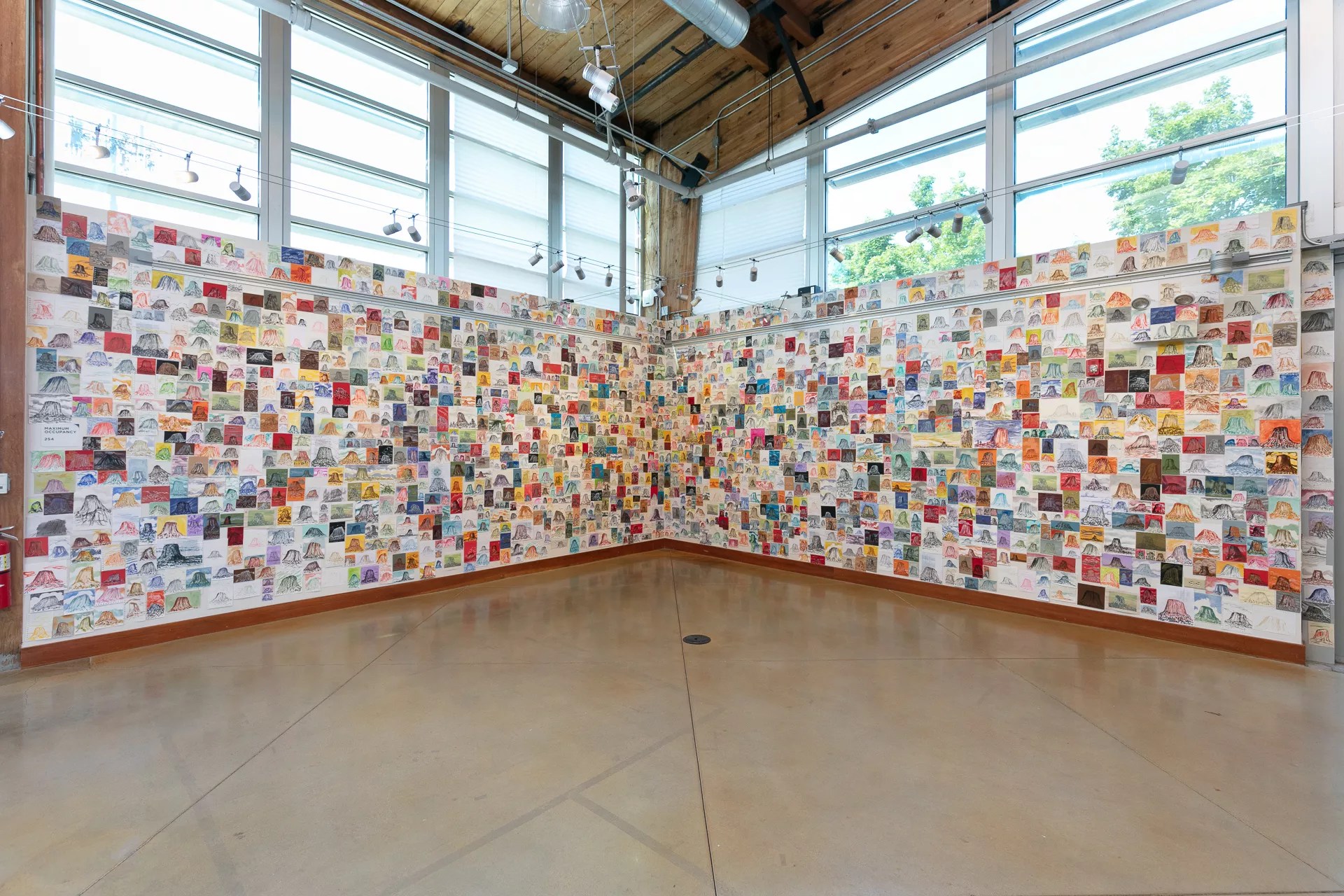
Wes Magyar

Audio By Carbonatix
Between heatwaves and thunderstorms over the last few weeks, one of the best places to enjoy the great outdoors has been inside a Denver art gallery. Three current shows all explore natural forms in some way: literally at the Art Gym, figuratively at William Havu, and conceptually at David B. Smith. (Smith also has a show about social issues that looks at a different kind of nature – human nature.)
Trine Bumiller’s contemporary landscapes anchor Trine Bumiller: Close Encounters at the Art Gym. Bumiller has created 2,000 depictions of Devils Tower, the otherworldly outcropping in Wyoming that became the country’s first national monument in 1906, when Teddy Roosevelt founded the program. It would later gain pop-cultural fame with the release of 1977’s Encounters of the Third Kind, in which it played a starring role. The title of Bumiller’s show represents a tip of the hat to the sci-fi blockbuster.
For some years, Bumiller has been interested in what could be called marathon series, exemplified by the 100 paintings she did to represent the 100th anniversary of Rocky Mountain National Park that were presented at the McNichols Building in 2015. For Encounters, she’s created twenty times that many pieces, though the first show contained full-tilt paintings, while these are mostly works on paper, which can be done more quickly.
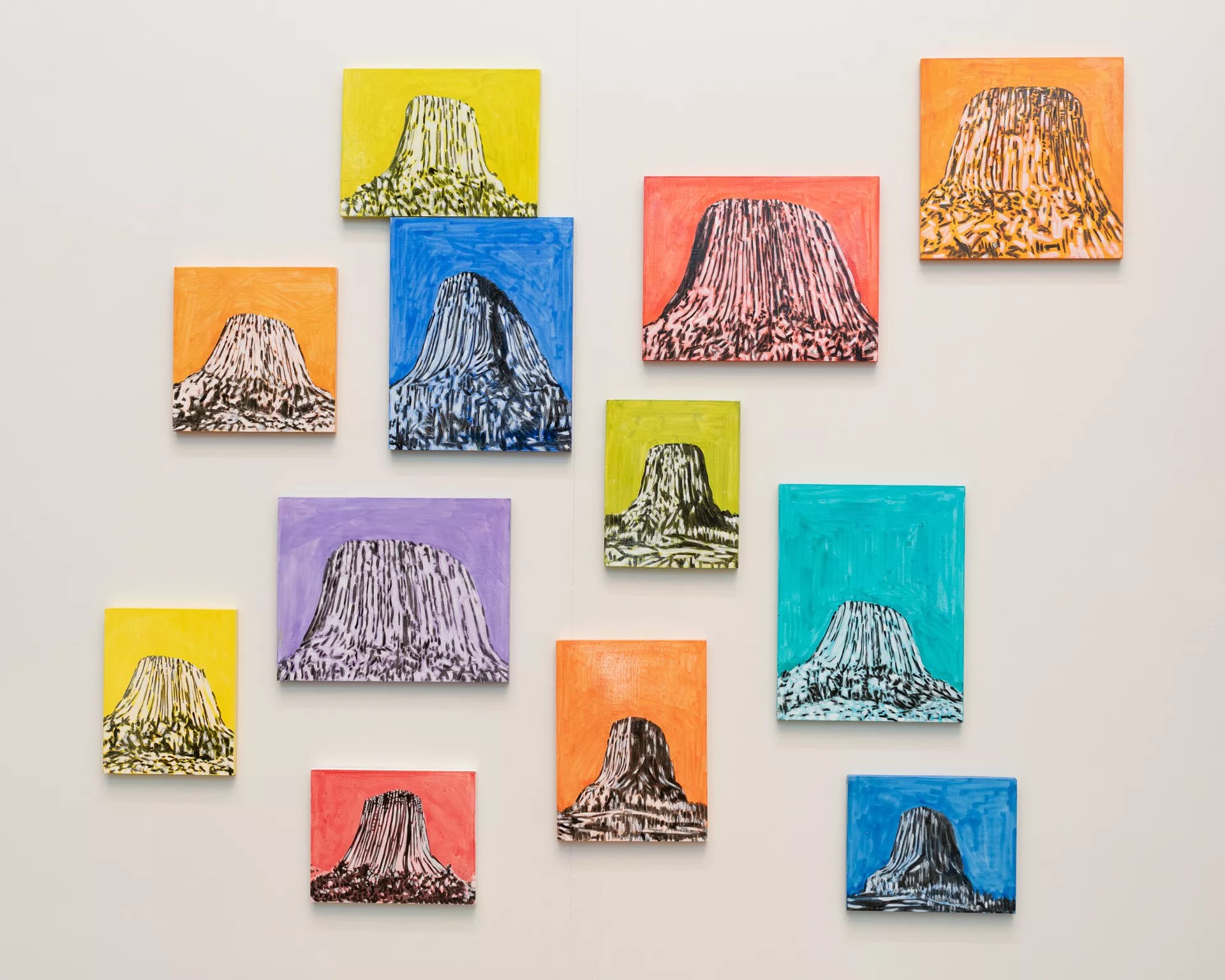
A group of oil-on-panel depictions of Devils Tower in Trine Bumiller: Close Encounters .
Wes Magyar
Denver, make your New Year’s Resolution Count!
We’re $17,500 away from our End-of-Year campaign goal, with just a five days left! We’re ready to deliver — but we need the resources to do it right. If Westword matters to you, please contribute today to help us expand our current events coverage when it’s needed most.
While Bumiller also did a handful of oil-on-panel paintings of Devils Tower, the showstopping sight is the installation of those thousands of works on paper. Bumiller has covered several walls of the ground-floor gallery space with the repeated images, like some kind of over-the-top wallpaper. In another unifying component, all of pieces have been similarly rendered: Bumiller reduces and conventionalizes her views of the rock through the use of simple bold strokes and marks. Despite the repetition of the same subject done in a similar style over and over, each of the works has an unexpectedly individualist look. That’s partly because the depictions have been done on different-sized pieces of paper, though all are small. Also contributing to the diversity are the various palettes she uses and the many different techniques she employs. Bumiller has labeled nearly everything in the show as being a mixed-media work, but some look like watercolors, others like drawings, and surely there’s a monotype or two among innumerable other techniques. The results are dazzling, and a great excuse to check out the Art Gym. Regan Rosburg’s “Jardin Du Soir” (left) and “Printemps” in Unseen Nature. Nick Ryan, courtesy the William Havu Gallery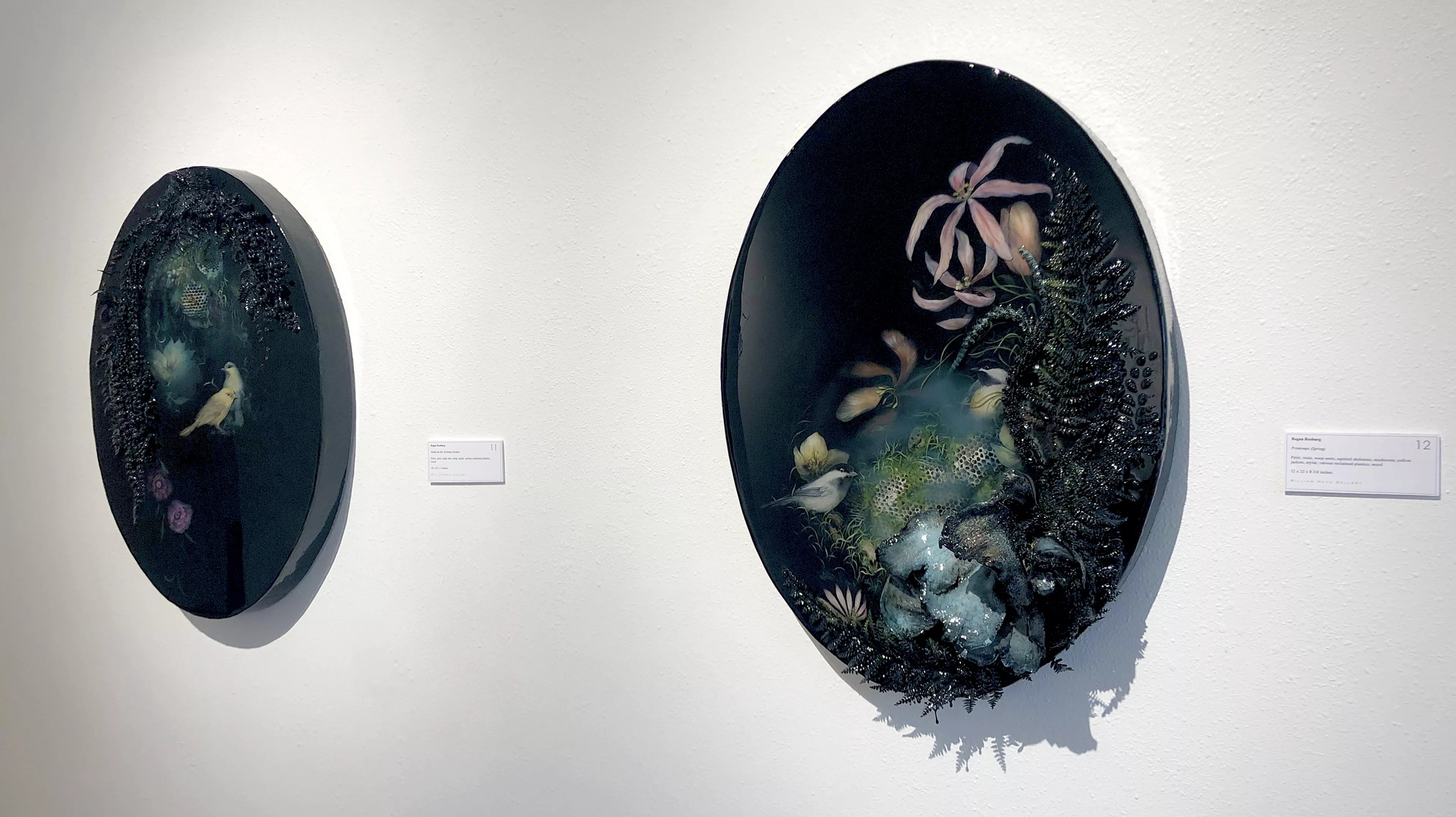
Unseen Nature, at the William Havu Gallery, is a group show of artists who are also looking at the environment. On the main floor, Regan Rosburg is represented by roundels covered in resin that hang on the walls. These circular panes have been embedded and encrusted with natural materials, including dried flowers, animal bones and insects, along with painted elements. The objects are submerged in the murky black resin, and only reveal themselves when the pieces are carefully examined. They have a decidedly funereal air, like Victorian mementos of death, and that’s intentional: Rosburg is using her work to mark the ecological devastation of the planet. Despite this downer vibe, the pieces appear extremely poetic.
Opposite the Rosburgs are a series of pierced wall-hung reliefs by Katie Caron that have been fabricated from either steel or polystyrene with the help of digitally driven laser cutters. At first glance, these bas-reliefs appear to be spare abstractions based on fruit- or flower-laden twigs, but their titles refer to “neurons,” clueing viewers to the fact that they’re actually inspired by the nervous systems of humans and animals. That the familiar overall shape of these neurons and their connections would resemble shapes found in nature makes its own point about the organization of the universe. Caron is a relentlessly experimental artist, and these airy sculptures are her latest attempt to stretch. There’s also a floor sculpture of aggregated spheres, “Oxytocin Polymer,” which she created with Martha Russo. This, too, refers to the body: Oxytocin is a hormone in the brain.
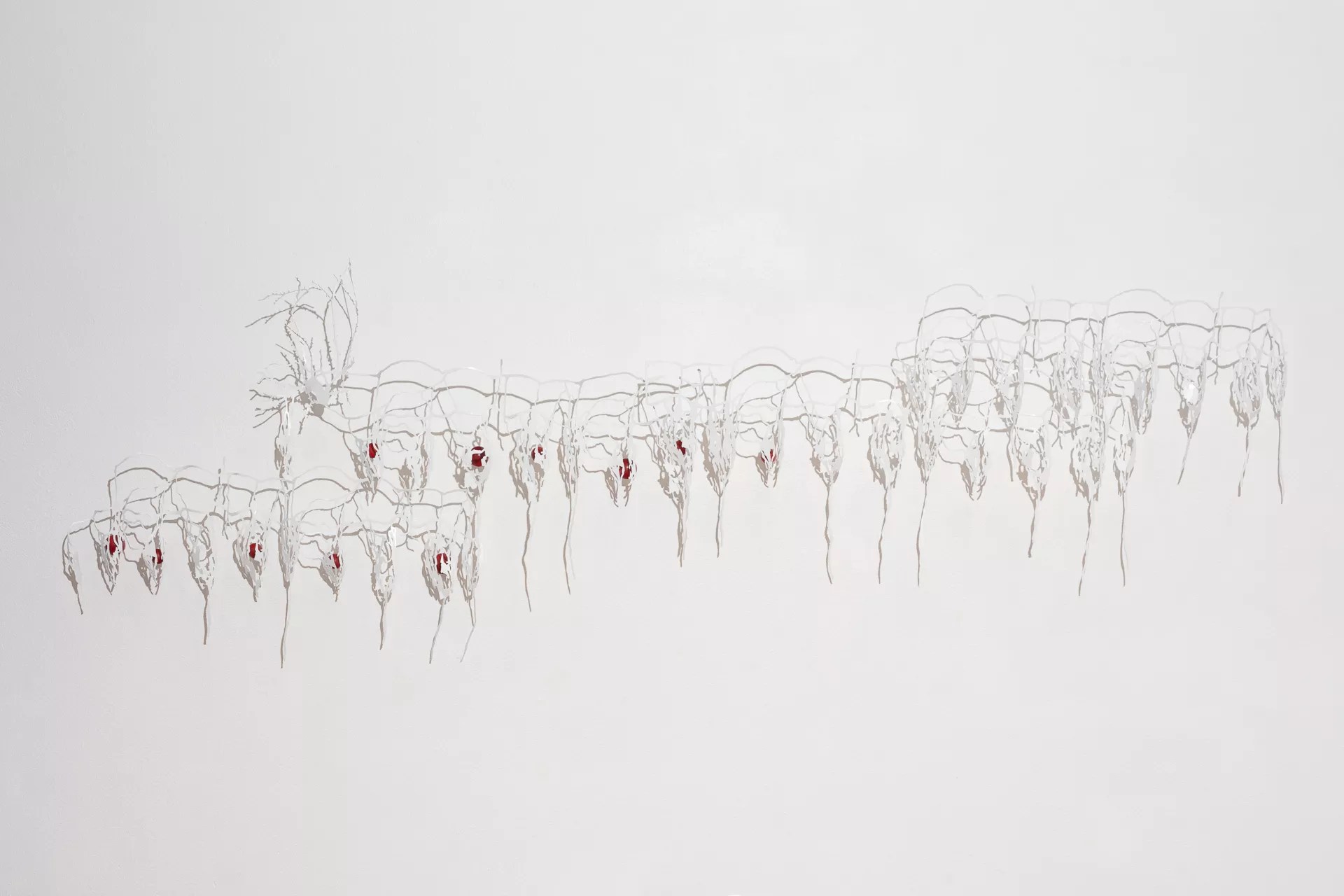
“Basket Neurons,” by Katie Caron, in Unseen Nature.
Nick Ryan, courtesy the William Havu Gallery
The last of the artists on the first floor is Naomi Scheck, who shows her signature monumental drawings. Scheck is interested in creating an overall formal composition assembled from arrangements of hundreds of tiny drawn elements brought together to make pictorial elements evocative of the natural world. Sometimes Scheck has cut away at the edges of the papers, and some papers are curved or partly folded. These characteristics add a sculptural quality to her pieces, even if they are still drawings.
The final artist in Unseen Nature is Laura Truitt, whose work is on Havu’s mezzanine level. Truitt’s paintings layer representational imagery, to somewhat abstract effect. She lays in a landscape and then paints it over with imaginary structural forms – typically, flat rectilinear planes that hang in space in front of the scene. The combined imagery allows the bright colors of the planes to dominate as the subtle tones used for the landscape behind recede in prominence, becoming geometric free-for-alls. (The Truitts look great with the nearby Sheryl Zacharia ceramics that incorporate similar colliding shapes, even if they aren’t officially part of the show.)
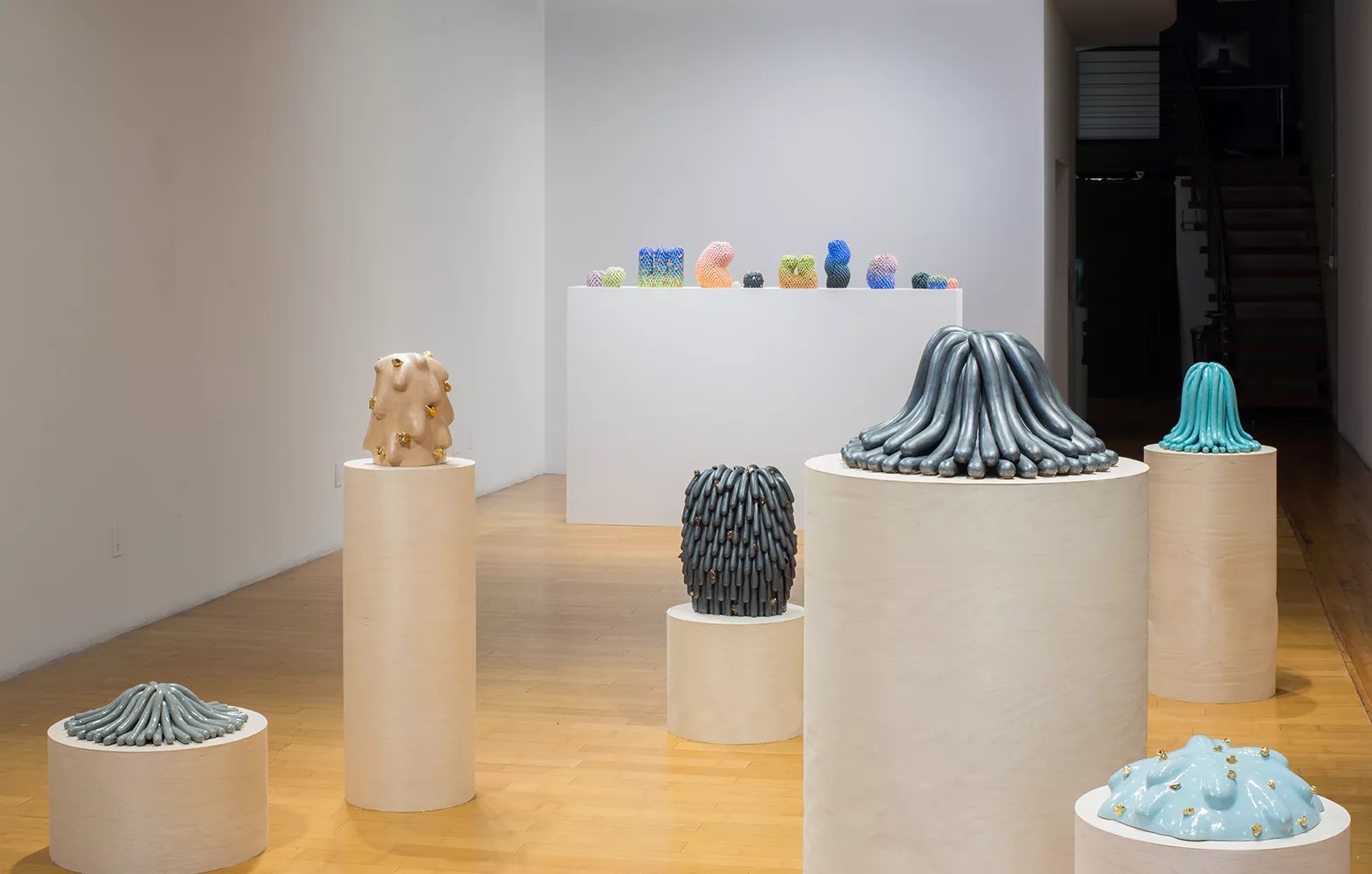
Installation view of Linda Lopez: Stranger.
Matthew Pevear
The ceramics that make up Linda Lopez: Stranger at the David B. Smith Gallery do sport some pretty strange shapes that suggest undersea life, especially corals. Lopez studied with two important ceramics artists at the University of Colorado Boulder – Scott Chamberlin and Kim Dickey; knowing this, I could see their separate influences. Lopez has cleverly conflated Chamberlin’s approach to form with Dickey’s tendency to use small repeated shapes to make her surfaces, but Lopez’s fabulous outcomes have their own distinctive signature.
As usual at Smith, the installation is spare and elegant, with the sculptures on custom-made veneered cylinders, with a row of objects placed on a high plinth. The sculptures are much larger than the objects, which are essentially tabletop miniatures, but the objects are also much more complex, essentially overlaid with hanging polyps of glazed clay. In “Orange/Pink Bend Ombre Dust Furry,” the shape is a bent cylinder with a domed top. It has been entirely covered in extruded clay drops, then glazed in shades of pink. The simpler sculptures fall into a couple of categories: those that look like ornamented boulders, and those that suggest multi-tentacled sea creatures made of tubes of extruded clay gathered in the center. “Sand Nubby” falls into the first category as a lumpy, sand-colored mound with thin gilt shards placed here and there. The second type is not really meant to look organic; with “Sea Green Mop,” for example, the title indicates that Lopez is actually getting at the look of a mop head.
Gay Renaissance, in the small project room, is a non sequitur to the Lopez display both aesthetically and thematically. Whereas Lopez’s chaste shapes are scrupulously finished with a minimal exhibition design, the wall installation of Gay Renaissance is informed by a more-is-more sensibility. The space is draped in found and handmade fabrics and fibers that seem to include scraps of everything but the kitchen curtains, and LGBT-positive messages are inserted amid the cloth. The installation is a collaborative work by the Secret Love Collective, founded in 2017 to “create worlds that don’t yet exist.”
Summer may be waning, but you can still enjoy the great outdoors inside these three galleries.
Trine Bumiller, through September 6, Art Gym Gallery,1460 Leyden Street, 303-320-8347, artgymdenver.com.
Unseen Nature, through September 14, William Havu Gallery, 1040 Cherokee Street, 303-893-2360, williamhavugallery.com.
Linda Lopez and Gay Renaissance, through September 14, David B. Smith Gallery, 1543 #A Wazee Street, 303-893-4234, davidbsmithgallery.com.